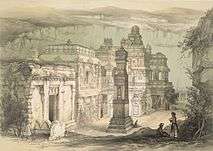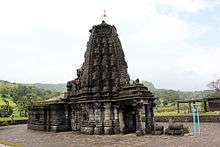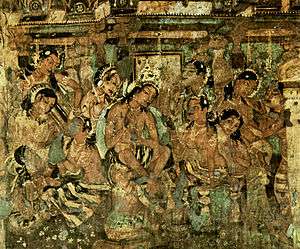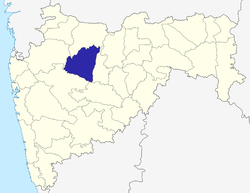Ellora Caves
| Ellora Caves | |
|---|---|
|
Cave 16 of the Kailasanatha Temple, viewed from the top of the rock | |
| Location | Maharashtra, India |
| Coordinates | 20°01′26″N 75°10′40″E / 20.02389°N 75.17778°ECoordinates: 20°01′26″N 75°10′40″E / 20.02389°N 75.17778°E |
| Type | Cultural |
| Criteria | i, iii, vi |
| Designated | 1983 (7th session) |
| Reference no. | 243 |
| UNESCO Region | Asia-Pacific |
Ellora (\e-ˈlȯr-ə\, IAST: Vērūḷ) is one of the largest rock-cut monastery-temple caves complexes in the world, and a UNESCO World Heritage Site in Maharashtra, India. The site presents monuments and artwork of Buddhism, Hinduism and Jainism from the 600-1000 CE period.[1][2] Cave 16 of Ellora features the largest single monolithic rock excavation in the world, the Kailasha temple, a chariot shaped monument dedicated to Shiva. The Kailasha temple excavation also presents the gods, goddesses and mythologies found in Vaishnavism, Shaktism and relief panels summarizing the two major Hindu Epics.[3][4][5]
The site features over 100 caves, of which 34 caves are open to public.[3] These were excavated out of the vertical basalt cliff in the Charanandri hills. These consist of 12 Buddhist (caves 1–12), 17 Hindu (caves 13–29) and 5 Jain (caves 30–34) caves.[6][7] Each group presents the respective deities and mythologies prevalent in 1st millennium CE, as well as the monasteries of that religion.[6] They were built in proximity and illustrate the religious harmony prevalent in ancient India.[2][8] All Ellora monuments were built by Hindu dynasties, such as the Rashtrakuta dynasty who built some of the Hindu & Buddhist group of caves, and Yadav dynasty who built some of the Jain group of caves.[3][9]
Ellora was an important historic commercial center of the Deccan region, located on an ancient trade route of South Asia.[10] The caves served as monasteries for monks, temples for prayers and a place for pilgrims to rest,[7] but now is an archaeological site. It is 29 kilometres (18 miles) north-west of the city of Aurangabad, and about 300 kilometres (190 miles) east-northeast from Mumbai. Ellora Caves, along with the nearby Ajanta Caves, form one of the major tourist attractions in Marathwada region of Maharashtra. Ellora is a protected monument under the Archaeological Survey of India.[11]
Etymology
Ellora, also called Verul or Elura, is the short form of the ancient name Elapura,[12] the latter found in ancient references such as the Baroda inscription of 812 CE which describes the magnificence of the Kailasha temple (Cave 16) at "Elapura".[3] In the Indian tradition, each cave is named and has a suffix Guha (Sanskrit), Lena or Leni (Marathi), which means caves.[3][13]
Location

Ellora caves are located in the Indian state of Maharashtra. They are about 29 kilometres (18 miles) northwest from the city of Aurangabad, 300 kilometres (190 miles) east-northeast from Mumbai, and about 100 kilometres (62 miles) west from Ajanta Caves.
Ellora occupies a relatively flat rocky region of the Western Ghats. Ancient volcanic activity in this area created many layered basalt formations, known as Deccan Traps. Formed during the volcanic activity of the Cretaceous geological period, one such west-facing cliff houses the Ellora Caves. Its vertical face made access to many layers of rock formations easier, enabling architects to pick basalt with finer grains for more detailed sculpting.[14]
Chronology
Starting with the colonial British era scholarship on Ellora caves, the overlapping styles of artwork between the Buddhist, Hindu and Jaina caves have led to many different chronology proposals, with no universal consensus.[15] The disagreements have broadly been two fold. One being whether Buddhist or Hindu caves were carved first, and the second scholarly disagreement being the relative dating of caves within a specific tradition. The broad consensus that has emerged is based on comparing the style and content of artwork at the Ellora caves to other ancient and early medieval era cave temples in the Deccan region that have been dated, textual records of various dynasties, and by including epigraphical evidence such as inscriptions found at various archaeological sites near Ellora and elsewhere in Maharashtra, Madhya Pradesh and Karnataka.[16][17] These studies suggest, state Geri Hockfield Malandra and other scholars, that the Ellora caves had three chronologically important building periods: an early Hindu period (~550 to 600 CE), a Buddhist phase (~600 to 730 CE), a later Hindu and Jain phase (~730 to 950 CE).[16][18][19]
The earliest Ellora caves may have been built during the rule of the Hindu dynasties of Vakataka (known for sponsoring the Ajanta caves) and Traikutakas. However, it is more likely that some of the earliest Ellora caves, such as Cave 29 (Hindu), were built by the Shiva-inspired Kalachuri Hindu dynasty, while the Buddhist caves were built by the Chalukya Hindu dynasty.[16] The later Hindu caves and early Jaina caves were built by the Hindu Rashtrakuta dynasty, while the last Jaina caves were built by the Yadava Hindu dynasty who also sponsored other Jaina cave temples.[20][21][22]
The Buddhist monuments: Caves 1-12
.jpg)
These caves are located on the southern side of the Ellora cave collection, and were built between 600-730 CE.[24] It was initially thought that the Buddhist caves were the earliest structures that were created between the fifth and eighth centuries, with caves 1-5 in the first phase (400-600) and 6-12 in the later phase (650-750). Modern scholarship places some of the Hindu caves before the Buddhist caves were built.[24][25] The earliest Buddhist cave is Cave 6, chronologically followed by 5, 2, 3, 5 (right wing), 4, 7, 8, 10 and 9.[26] Caves 11 and 12, also called the Do Thal and Tin Thal respectively, were the last.[27] All the Buddhist caves were constructed between 630-700.[26]
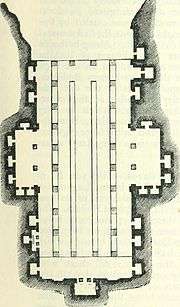
Eleven out of twelve Buddhist caves consist of viharas,[24] or monasteries with prayer halls: large, multi-storeyed buildings carved into the mountain face, including living quarters, sleeping quarters, kitchens, and other rooms. The monastery caves have shrines including carvings of Gautama Buddha, bodhisattvas and saints. In some of these caves, sculptors have endeavoured to give the stone the look of wood.
Caves 5, 10, 11 and 12 are architecturally important Buddhist caves. Cave 5 is unique because it is designed as a hall with two parallel refectory benches in the center with a Buddha statue in the rear.[28] Cave 5 of Ellora and Cave 11 of the Kanheri Caves are only two such Buddhist caves in India.[10] Cave 10 is called the Vīśvakarmā Cave, a major Buddhist prayer hall.[10] Amongst other Buddhist caves, all of the first nine (caves 1–9) are monasteries.

Caves 11 and 12 are three-storied Mahayana monastery caves with idols, mandalas carved into the walls, and numerous goddesses and Bodhisattva-related artwork belonging to the Vajrayana Buddhism. These are compelling evidence to suggest that Vajrayana and Tantra ideas of Buddhism were well established in South Asia by the 8th century CE.[10][29]
The Vishvakarma Cave
Most famous of the Buddhist caves is Cave 10, a worship hall called the 'Vishvakarma cave' (literally the cave of one who accomplishes everything, or the architect of the gods). It is also known as the "Carpenter's Cave", because the artistic finish gives the rock an appearance of wooden beams. Beyond its multi-storeyed entry is a cathedral-like stupa hall also known as chaitya-griha (prayer house). At the heart of this cave is a 15-foot statue of Buddha seated in a preaching pose. It was likely built around 650 CE.[30][31]
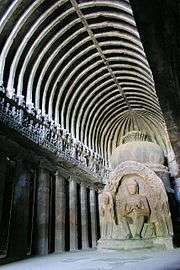
Cave 10 combines a vihara with a chapel-like worship hall with eight subsidiary cells, four in the back wall and four in the right wall.[32] It had a portico in the front with a cell.[26] It is the only dedicated chaitya griha amongst the Buddhist group of Ellora caves. It follows the pattern of construction of Caves 19 and 26 of Ajanta, and features a chandrashala (arched window) and a side connection to Cave 9 of Ellora.[30]
The main hall of the Visvakarma cave is apsidal on plan and is divided into a central nave and side aisles by 28 octagonal columns with plain bracket capitals. In the apsidal end of the chaitya hall is a stupa on the face of which a colossal high seated Buddha in vyakhyana mudra (teaching posture). A large Bodhi tree is carved at his back. The hall has a vaulted roof in which ribs (known as triforium) have been carved in the rock imitating the wooden ones.[33] The friezes above the pillars are Naga queens, and the extensive relief artwork shows characters as entertainers, dancers and musicians.
The front of the prayer hall is a rock-cut court, which is entered through a flight of steps. The triple entrance of the Cave has a dramatic facade is well carved with Indian motifs such as apsaras and meditating monks.[32] Upstairs, on either side are pillared porticos with small rooms in their back walls. The pillared verandah of the chaitya has a small shrine at either end and a single cell in the far end of the back wall. The corridor columns have massive square-shaped shafts and ghata-pallava (vase and foliage) capitals. The various levels of Cave 10 feature, in addition to the large Buddha idol, the male and female deity idols, carved in the Pala dynasty style found in eastern regions of India, such as those of Maitreya, Tara, Avalokitesvara (Vajradhamma), Manjusri, Bhrkuti and Mahamayuri, some with four or six arms.[34] The artwork also shows the influence of southern Indian style.[35]
The Hindu monuments: Caves 13-29


The Hindu caves were constructed between the middle of sixth century to the end of the eighth century, in two periods. Nine cave temples were excavated beginning in the 6th century.[36][37] Along with these nine, four other caves (caves 17–29) were constructed during the Kalachuri period. The work first commenced in Caves 28, 27 and 19. These were followed by two most impressive caves constructed in the early phase – Caves 29 and 21. Along with these two, work was underway at Caves 20 and 26, and slightly later at Caves 17, 19 and 28.[38][39]
The later caves such as 14, 15 and 16 were constructed during the Rashtrakuta period, some dating to 8th to 10th-centuries.[40] The work began in Caves 14 and 15 and then in Cave 16,[38] which were completed in the 8th-century with the support of king Krishna I.[41][42] All these structures represent a different style of creative vision and execution skills. Some were of such complexity that they required several generations of planning and co-ordination to complete.
Early Hindu temples: Dhumar Lena, Cave 29
.jpg)
All early Hindu caves started before any Buddhist or Jaina caves were carved. These early caves were dedicated to Hindu god Shiva, although the iconography suggests that the artists gave other gods and goddesses of Hinduism prominent and equal reverence. All these cave temples contain a rock cut linga-yoni within the core of the shrine, surrounded by a space for circumambulation (parikrama). Cave 29, also called Dhumar Lena, is one of earliest excavations in Ellora and among the largest.[43]
The carvings in Cave 29 are large, much bigger than life size, but states Dhavalikar, they are "corpulent, stumpy with disproportionate limbs" unlike the elegant perfection found in many other Ellora caves.[44]
Dhumar Lena is integrated with a natural waterfall, called "Vale Ganga" which can be watched from a southern balcony carved out of the rock cliff by the artists. According to Havell, the stream in monsoon appears as if "Ganga is falling over great Shiva's brow".[45] Most of the early Hindu temple building was centered around this natural waterfall.[45][39]
Rameshwar temple, Cave 21
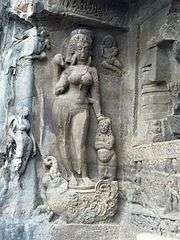
Cave 21, also called Rameshwar Lena, is another early excavations in Ellora and among the most elegant.[46][47] It was built before the Rashtrakuta dynasty came to power and began a major expansion work at Ellora. Rameshwar Leni is credited to the Kalachuri dynasty.[3]
Cave 21 features several unique artworks, as well as panels and carvings that are found in other Ellora caves. For example, the reliefs that depict the story of goddess Parvati's pursuit of god Shiva, her Tapas is unique. The artwork that depicts her wedding to Shiva, of dancing Shiva, of Kartikeya (Skanda), Shiva and Parvati playing couple games in their leisure, and others are found in other caves.[48] Among its large panels is the reverent display of Sapta Matrika, or seven mother goddesses of the Shaktism tradition of Hinduism, flanked on the two sides by Ganesha and Shiva.[48] Inside the temple, are other important Shakti tradition goddesses such as the Durga. The entrance to Cave 21 features elegantly carved gigantic sculptures of goddesses Ganga and Yamuna on each side, thus emphasizing and reverentially presenting the two major Himalayan rivers and their significance to the Indian culture.[49]
The entire cave is symmetric, laid out on mandapa square principle, with embedded geometric patterns. The Shiva linga at the sanctum sanctorum of the temple is equidistant from the major statues of goddesses Ganga and Yamuna, all three set in an exact equilateral triangle.[50] Along the lines of this triangle are other major artworks such as those of the dvarapalas.[49] According to Carmel Berkson, this likely symbolizes the Brahman–Prakriti relationship, the interdependence of the masculine and the feminine energies, that is central to Hindu theology.[49] Similarly, within the major panels are embedded geometric patterns, such as one for Durga and the buffalo demon wherein the carvings embed her hexagram yantra.[51]
The Kailaśa temple: Cave 16
Cave 16, also known as the Kailasa temple, is considered one of the most remarkable cave temples in India because of its size, architecture and having being entirely carved out of a single living rock.[52][53]
The Kailasha temple is dedicated to Shiva, in a structure reminiscent of mount Kailash.[54] It is modeled like other Hindu temples, with a gateway, an assembly hall, a multi-storey[55] main temple surrounded by a galaxy of shrines all of which are set using the square principle, integrated space for circumambulation, a garbha-grihya (sanctum sanctorum) wherein is the linga-yoni and a spire shaped like mount Kailash – all of which have been carved out a single rock.[53][56] Detached shrines in this excavation from the same rock are to Ganga, Yamuna, Saraswati, each of the ten avatars of Vishnu, the Vedic gods and goddesses such as Indra, Agni, Vayu, Surya and Usha, as well as non-Vedic deities such as Ganesha, Ardhanarishvara (half Shiva, half Parvati), Harihara (half Shiva, half Vishnu), Annapurna, Durga and others.[52][53][57] The basement level of the temple reverentially features a range of artwork of Shaivism, Vaishnavism and Shaktism, such as twelve episodes from the childhood of Krishna, an important theme in Vaishnavism.[58]
The structure is a freestanding, multi-storeyed temple complex, covers an area double the size of Parthenon in Athens.[59] It is estimated that the artists carefully removed three million cubic feet of stone to create and shape the Kailasha temple,[53] or about 200,000 tonnes of basaltic rock.[54]
The construction of the temple is often attributed to the Rashtrakuta king Krishna I (r. 756-773 CE), based on certain epigraphs.[60] The temple shows traces of Pallava style.[61] The dimensions of the courtyard are 82 meters x 46 meters at the base, and 30 meters high (280 x 160 x 106 feet).[56] The entrance features a low gopuram. The central shrine housing the lingam features a flat-roofed mandapa supported by 16 pillars, and a Dravidian shikhara. An image of Shiva's mount Nandi (the sacred bull) stands on a porch in front of the temple.[52] The panels on two walls of the main temple consist of rows of carvings, which top to bottom like a text book, present a pictorial summary of the Mahabharata (north side) and the Ramayana (south side).[62]
The Kailasha temple is encyclopedic in its expression and reach, dynamic and among the most admired temple from 1st millennium Indian history.[63][5][54] Among the rock-cut carved artworks, states Carmel Berkson, the Kailasha temple is one of the wonders of the world.[64]
The Dashavatara: Cave 15
The Dashavatara temple or Cave 15 is another significant excavation, built long after the Cave 14 (Ravan ki Khai, Hindu) was built. Cave 15 has cells and a layout plan that are partly similar to Buddhist Caves 11 and 12. This suggests it might have been intended to be a Buddhist cave, but Cave 15 also has elements such as a Nrtya Mandapa (Indian classical dance pavilion) at its entrance, a feature never found in Buddhist cave plans and which suggests that the Cave 15 design was never intended to be Buddhist. According to James Harle, Hindu images are found in Buddhist Cave 11, many Hindu deities are incorporated in Buddhist caves of the region, and this mutual overlap in otherwise different designs between Buddhist and Hindu caves may be because of shared architects and workers, or perhaps a planned Buddhist cave was adapted into a Hindu monument.[65][66]
According to Geri Malandra, all the Buddhist caves at Ellora were an intrusion in a place that was already an established Brahmanical Tirtha (Hindu pilgrimage site), and not the other way around. Further, given that both the Hindu and Buddhist caves were predominantly anonymous, and no donative inscriptions have been discovered for Buddhist Ellora caves other than those of Hindu dynasties that built them, the original intent and nature of these cave temples is speculative.[67]
The Hindu temple housed in Cave 15 has an open court with a free-standing monolithic mandapa at the middle and a two-storeyed excavated temple at the rear. Large sculptural panels between the wall columns on the upper floor illustrate a wide range of themes, which include the ten avatars of Vishnu. An inscription of Dantidurga, important to establishing the chronology of the temple, is on the back wall of the front mandapa. According to Coomaraswamy, the finest relief of this cave is the one depicting the death of Hiranyakashipu, where Vishnu in man-lion (Narasimha) form, emerges from a pillar to lay a fatal hand upon the shoulder of Hiranyakashipu.[68] Other reliefs in Cave 15 include the Gangadhara, marriage of Shiva and Parvati, Tripurantika of Shaktism tradition, Markendeya, Garuda, aspects of life, Nandi in mandapa, dancing Shiva, Andhakasura, Govardhanadhari, Gajendravarada and others.[69] The panels are arranged in dyads, which states Carmel Berkson, reinforce each other by displaying "cooperative but also antagonistic energy" with a mutuality of power transference.[70]
Other Hindu caves
Other notable Hindu caves are the Ravan ki Khai (Cave 14) and the Nilkantha (Cave 22) also have several sculptures. Cave 25 features Surya carved in its ceiling.
The Jain monuments: Caves 30-34


The five Jain caves at Ellora are located on the north end of Ellora caves complex. They were mostly excavated in the ninth and early tenth centuries, and belong to the Digambara sect.[71][72] The Jain caves are not as large as the Buddhist and Hindu caves at Ellora, but they present exceptionally detailed art works. They were co-built with the later era Hindu caves at Ellora, and both share architectural and devotional ideas such as pillared veranda, symmetric mandapa and puja (worship).[73] However, unlike the Hindu temples at Ellora, the emphasis in the Jain caves is the depiction of twenty four Jinas (spiritual conquerors who have gained liberation from the endless cycle of rebirths).[74] Along with these Jinas, the Jain temples present a galaxy of gods and goddesses along with yaksa (male nature deity), yaksi (female nature deity) and human devotees prevalent in Jaina mythology of 1st millennium CE.[75]
According to Jose Pereira, the five Jain Ellora Caves were actually 33 chronologically distinct excavations, which he has labelled as J1 to J33.[74] Pareira uses epigraphy, palaeography, typology, style, mechanics and historical background in texts to conclude that the Jain caves at Ellora likely began in late 8th-century.[76] Some construction and excavation activity in the Jain caves continued past the 10th century, states Owen, until the 13th century before coming to a halt with the arrival of Islamic Sultanate wars in the region.[77] This is evidenced by votive inscriptions dated to 1235 CE, where the donor states to have "converted Charanadri into a holy tirtha" for Jains by gifting the excavation of lordly Jinas.[78]
The most remarkable Jain shrines are the Chhota Kailash (cave 30, 14 excavations), the Indra Sabha (cave 32, 13 excavations) and the Jagannath Sabha (cave 33, 4 excavations).[74] Cave 31 is an unfinished four-pillared hall and a shrine.[79] Cave 34 is a small cave, which can be approached through an opening on the left side of Cave 33.[80]
Amongst its devotional carvings, the Jain Ellora caves offer some of the earliest Samavasarana images. Samavasarana is of special interest to Jains, as it is a hall where the Tirthankara preaches after attaining Kevala Jnana (liberating omniscience).[81] Of interest is the pairing of Jinas, particularly of Jina Parsvanatha and Kevalin Bahubali which appear 19 times in the Ellora caves of Jainism.[82] Other artwork of significance in the Jain caves include those of deities Sarasvati, Sri, Saudharmendra, Sarvanubhuti, Gomukha, Ambika, Cakresvari, Padmavati, Ksetrapala and Hanuman.[83]
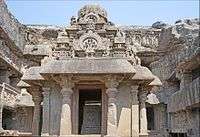
The Indra Sabha: Cave 32
The Indra Sabha (Cave 32) is a two storeyed cave with a monolithic shrine in its court. This cave was excavated in the 9th century. In the 19th-century, colonial era historians confused all the Jain Yaksas to be alternate images of Indra found in Buddhist and Hindu artworks, giving this temple the name "Indra Sabha", a misnamed appellation that has since then become its standard name.[84] The temple and other Jaina caves, however, do feature an Indra like Buddhist and Hindu caves do, as he is one of the 64 deities who live in the heavenly world in Jain cosmology, with Indra being the king of the first Jain heaven called the Saudharmakalpa and the chief architect of the celestial assembly hall in Jain texts such as the Adipurana.[85]
The Indra Sabha Jain temple is historically significant as it contains evidence of active worship inside by the Jain community, in the form of layered deposits and textual records. Rituals were held in the upper level, the images worshipped, and the artwork in this temple were the focus of these rituals and celebrations.[86]

The Cave 32 features very fine carvings, such as those of the lotus flower on the ceiling. The upper level of the double-storied shrine excavated at the rear of the court, an image of Ambika, the yakshini of Neminath, is found seated on her lion under a mango tree, laden with fruits. The center of the shrine presents Sarvatobhadra, where four Tirthankaras of Jainism – Rshibha (1st), Neminatha (22nd), Parsvanatha (23rd) and Mahavira (24th) are aligned to the cardinal directions, forming a place of worship for Jain devotee.[87]
Chotta Kailasha: Cave 30
The Chotta Kailasha, or the little Kailasha, got its name because of carving resemblances between it and the monumental Cave 16 Hindu Kailasha temple in the Ellora complex. It features two larger-than-life size reliefs of dancing Indra, who is wearing beautiful ornaments, a crown and has multiple arms (8 arms in one, 12 arms in the other); Indra's arms are shown in various mudra just like dancing Shiva artworks found in nearby Hindu caves.[88] However, the iconography has several differences which establish that the Cave 30 Jain temple shows a dancing Indra, and not a dancing Shiva. The Indra panels at the entrance also feature other deities, celestials, musicians and dancers as if one is entering a temple of celebration and joy.[89]
Scholars, states Owen, have questioned whether such music, dance and frolicking were a part of the Jaina layperson spirituality in the 9th century, given that Jain theology cherishes meditative asceticism. Rajan, for example, has proposed that Cave 30 may have originally been a Hindu monument that was later converted into a Jaina temple. In contrast, Owen suggests that the celebration-filled artwork in this temple is better understood as part of the Samavasarana doctrine in Jainism.[89]

The overlap between Jain and Hindu mythologies is significant to be a source of confusion, states Owen, given Book Three of the Hindu Mahabharata describes Indra's abode as one filled with musicians, dancers, singers, apsaras, yogis and yoginis, amorous couples, saintly people and happily married sages, flowers, lotus ponds, blossoming trees, fragrant breezes and mythical heroes.[90] The Jain artwork in Cave 30 depicts these, much like the Hindu caves in the Ellora complex, to set the context of the temple.[90] As the devotee moves from the outer premises of the temple towards its central core, the symbolism shifts towards the core ideas of Jainism, greater presence of meditating images and a rising profile of the Jinas – the place where the Jain devotee would perform his or her ritual abhisheka (worship).[91]
The Chota Kailasha temple is an unfinished excavation, was likely built in early 9th century in parallel to the lower level of the Indra Sabha, decades after the main Kailasha temple at Ellora was complete.[92]
The Jagannatha Sabha: Cave 33
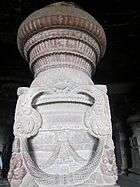
The Jagannatha Sabha (Cave 33) is the second largest Jain cave at Ellora. This cave dates back to the 9th century according to the inscriptions on the pillars. It is a two storeyed cave with twelve massive pillars and elephant heads projecting towards the porch, all carved out a single living rock. The hall has two heavy square pillars in front, four in the middle area, and a pillared interior square principle hall with fluted shafts, all intricately carved with capitals, ridges and brackets. Inside the major idols are of Parshvanatha and Mahavira, the last two Tirthankaras in Jainism.[93]
Other Jain caves
Cave 34 is the northern most cave of in Ellora, next to the Jagannatha Sabha. The porch of this cave is damaged. It features a colossal 5 meter idol of Parsvanatha.
This and other Jain caves excavations show intricate detailing. Many of the structures had rich paintings in the ceilings – fragments of which are still visible.
Visitors, desecration and damage
The Ellora caves were never forgotten.[94] There have been several written records, in the centuries that followed after their excavation, that indicate that these caves were visited regularly. Ellora was frequented by Buddhist monks in the 9th and 10th centuries. It is mentioned, somewhat incorrectly, by the Baghdad resident Al-Mas‘udi of the 10th century CE, as "Aladra", a site of a great temple, a place of Indian pilgrimage, one with thousands of cells where devotees live, for which an entire city is devoted.[95] In 1352 CE, the records of Ala-ud-Din Bahman Shah mention he camping at the site. The others are by Firishta, Thevenot (1633–67), Niccolao Manucci (1653-1708), Charles Warre Malet (1794), and Seely (1824).[96] Some of these accounts suggest the importance of Ellora, but include ahistorical claims. For example, the Venetian traveller Niccolao Manucci's description of Ellora caves based on interviewing Mughal officials claims, "many say that they were executed by the ancient Chinese".[95]
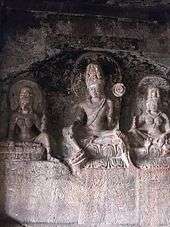
The Lalitacaritra, a Marathi text dated to late 13th century, is the first report that suggests that active use of Ellora stopped in the 13th century.[94] Islamic court records suggest that Deogiri capital of the Yadava dynasty, which is about 10 kilometers from Ellora, had come under sustained military raids and attacks at this time, and was conquered by the Delhi Sultanate in 1294 CE.[97] According to José Pareira, there is evidence that artist work in Jain caves at Ellora flourished under the Yadava dynasty ruler named Singhana (~1200-1247 CE), and these caves were in use by Jaina visitors and worshippers in the 13th-century, but all Jain religious activity ceased in Ellora after the region came under Islamic rulers in late 13th century.[98]
The Buddhist, Hindu and Jain monuments at Ellora show substantial selective damage particularly to the idols, while the intricate carvings on pillars and of natural objects on the walls are intact. The desecration of idols and images is traced to the 15th, 16th and 17th centuries when this region of the Deccan peninsula came under iconoclasm of Muslim armies.[99] Such devastation by faithful Muslims was, states Geri Malandra, from the offense of "the graphic, anthropomorphic imagery of Hindu and Buddhist shrines".[95] Muslim historians of the Islamic Sultanates period of Indian history mention Ellora, as they describe widespread damage and fanatical destruction of idols and artwork of the region, but some Muslims of this era expressed their concern against such wanton damage and "deplored it as a violation of beauty", according to Carl Ernst.[100]
Ellora inscriptions
Several inscriptions at Ellora[101] range from 6th century onwards. The best known of them is an inscription of Rashtrakuta Dantidurga (c. 753-57 A.D.) on the back wall of the front mandapa of Cave 15, which mentions that he offered prayers at this temple. Jain cave Jagannatha Sabha has 3 inscriptions that give the names of monks and donors. A Parshvanath temple on the hill has an 11th-century inscription that gives the name of the donor from Vardhanapura.
The Great Kailasa temple (Cave 16) is attributed to Krishna I (c. 757-83 A.D.), the successor and uncle of Dantidurga. A copper plate inscription found in Baroda, Gujarat narrates that a great edifice was built on a hill by Krishnaraja at Elapura (Ellora), as follows:[102]
...was caused to be constructed a temple on the hill at Elapura, of wonderful structure, on seeing which the best of immortals who move in celestial cars, struck with astonishment, say "This temple of Shiva is self-existent; in a thing made by art such beauty is not seen (...). The architect builder of which (...) was himself suddenly struck with astonishment, saying "Oh, how was it that I built it!"
— Karkaraja II copper inscription, 812 CE[103]
See also
References
- ↑ Owen 2012, pp. 1–2.
- 1 2 "Ellora Caves - UNESCO World Heritage Centre". Whc.unesco.org. 2008-03-06. Retrieved 2010-08-12., Quote: "These 34 monasteries and temples, extending over more than 2 km, were dug side by side in the wall of a high basalt cliff, not far from Aurangabad, in Maharashtra. Ellora, with its uninterrupted sequence of monuments dating from A.D. 600 to 1000, brings the civilization of ancient India to life. Not only is the Ellora complex a unique artistic creation and a technological exploit but, with its sanctuaries devoted to Buddhism, Hinduism and Jainism, it illustrates the spirit of tolerance that was characteristic of ancient India."
- 1 2 3 4 5 6 World Heritage Sites - Ellora Caves, Archeological Survey of India (2011), Government of India
- ↑ John Stratton Hawley (1981), Scenes from the Childhood of Kṛṣṇa on the Kailāsanātha Temple, Ellora, Archives of Asian Art, Vol. 34 (1981), pages 74-90
- 1 2 M. K. Dhavalikar (1982), KAILASA — THE STYLISTIC DEVELOPMENT AND CHRONOLOGY, Bulletin of the Deccan College Research Institute, Vol. 41, pages 33-45
- 1 2 Lisa Owen (2012). Carving Devotion in the Jain Caves at Ellora. BRILL Academic. pp. 1–10. ISBN 978-9004206298.
- 1 2 Norbert C. Brockman (2011). Encyclopedia of Sacred Places, 2nd Edition. ABC-CLIO. pp. 155–156. ISBN 978-1-59884-655-3.
- ↑ Time Life Lost Civilizations series: Ancient India: Land Of Mystery (1994)
- ↑ Gopal, Madan (1990). K.S. Gautam, ed. India through the ages. Publication Division, Ministry of Information and Broadcasting, Government of India. p. 178.
- 1 2 3 4 Pandit 2013.
- ↑ "Ellora Caves". Retrieved 2012-05-19.
- ↑ World Heritage Series ELLORA, Archaeological Survey of India, Government of India, Page 6. ISBN 81-87780-43-6. Printed by GoodEarth Publications, Eicher GoodEarth Limited @ Thomson Press, New Delhi
- ↑ Pia Brancaccio 2013, p. 2.
- ↑ "Geology of Ellora". ellora.ind.in.
- ↑ Walter M. Spink (1967). Ajanta to Ellora. Marg Publications. pp. 3–4, 35–40. OCLC 648366740.
- 1 2 3 Geri Hockfield Malandra (1993). Unfolding A Mandala: The Buddhist Cave Temples at Ellora. State University of New York Press. pp. 5–7. ISBN 978-0-7914-1355-5.
- ↑ Owen 2012, pp. 109–110.
- ↑ Owen 2012, pp. 7–9.
- ↑ Geri Malandra (1996). "The Mandala at Ellora / Ellora in the Mandala". Journal of the International Association of Buddhist Studies. 19 (2): 193.
- ↑ José Pereira (1977). Monolithic Jinas. Motilal Banarsidass. pp. 24, 21. ISBN 978-81-208-2397-6.
- ↑ Owen 2012, pp. 200–202.
- ↑ "Close view of base of pillars in the upper floor of the Jain Cave XXXIII (Jaganatha Sabha), Ellora.". Retrieved 2013-09-02.
- ↑ Geri Hockfield Malandra 1993, pp. 65-82.
- 1 2 3 Owen 2012, p. 8.
- ↑ Dhavalikar 2003, pp. 9-12, 33.
- 1 2 3 Dhavalikar 2003, p. 12
- ↑ James C. Harle (1994). The Art and Architecture of the Indian Subcontinent. Yale University Press. p. 132. ISBN 978-0-300-06217-5.
- ↑ James Burgess 1880, pp. 373-374.
- ↑ Damien Keown & Charles S. Prebish 2013, p. 23.
- 1 2 Geri Hockfield Malandra 1993, p. 51.
- ↑ James Burgess 1880, pp. 377-380.
- 1 2 Christopher Tadgell (2015). The East: Buddhists, Hindus and the Sons of Heaven. Routledge. pp. 78–82. ISBN 978-1-136-75384-8.
- ↑ Dhavalikar 2003, pp. 20–3
- ↑ Geri Hockfield Malandra 1993, pp. 53-60, 64-65.
- ↑ Geri Hockfield Malandra 1993, pp. 61-62.
- ↑ Owen 2012, p. 7.
- ↑ Walter M. Spink 1967b.
- 1 2 Dhavalikar 2003, p. 33
- 1 2 Walter M. Spink 1967a.
- ↑ Owen 2012, pp. 8-9.
- ↑ Madhukar Keshav Dhavalikar (1983). Masterpieces of Rashtrakuta Art: The Kailasa. Stosius. p. 3. ISBN 978-0865902336.
- ↑ Owen 2012, pp. 28-35.
- ↑ Dhavalikar 2003, pp. 81-84.
- ↑ Dhavalikar 2003, pp. 83-84.
- 1 2 Owen 2012, pp. 7-8.
- ↑ Dhavalikar 2003, pp. 73-79, 84.
- ↑ P. R. Srinivasan 2007, p. 23.
- 1 2 Berkson 1992, pp. 86-87, 134-135.
- 1 2 3 Berkson 1992, p. 124.
- ↑ Berkson 1992, p. 126.
- ↑ Berkson 1992, pp. 145-147.
- 1 2 3 "Section II: Periodic Report on the State of Conservation of Ellora Caves, India, 2003" (PDF). UNESCO. Retrieved 6 March 2016.
- 1 2 3 4 James G. Lochtefeld (2002). The Illustrated Encyclopedia of Hinduism: A-M. The Rosen Publishing Group. p. 331. ISBN 978-0-8239-3179-8.
- 1 2 3 Charles Higham (2014). Encyclopedia of Ancient Asian Civilizations. Infobase. p. 105. ISBN 978-1-4381-0996-1.
- ↑ Christopher Tadgell (2015). The East: Buddhists, Hindus and the Sons of Heaven. Routledge. pp. 114–117, see figure 1.55a for the three storey sectional detail. ISBN 978-1-136-75384-8.
- 1 2 Goetz, H. (1952). "The Kailasa of Ellora and the Chronology of Rashtrakuta Art". Artibus Asiae. 15 (1/2): 84–107. doi:10.2307/3248615. JSTOR 3248615.
- ↑ Dhavalikar 2003, pp. 37-38.
- ↑ John Stratton Hawley (1981), Scenes from the Childhood of Kṛṣṇa on the Kailāsanātha Temple, Ellora, Archives of Asian Art, University of Hawaii Press, Vol. 34 (1981), pages 74-90
- ↑ Sarina Singh; Joe Bindloss; James Bainbridge; Lindsay Brown; Mark Elliott; Stuart Butler (2007). India. Footscray, Vic.: Lonely Planet. p. 810. ISBN 978-1-74104-308-2.
- ↑ Owen 2012, pp. 135-136.
- ↑ Hermann Kulke; Dietmar Rothermund (2004). A History of India. Routledge. p. 120. ISBN 978-0-415-32920-0.
- ↑ Dhavalikar 2003, p. 56.
- ↑ Susan L. Huntington & John C.. Huntington 2014, p. 338.
- ↑ Berkson 1992, p. 30.
- ↑ James C. Harle (1994). The Art and Architecture of the Indian Subcontinent. Yale University Press. pp. 131–134. ISBN 978-0-300-06217-5.
- ↑ Owen 2012, p. 135.
- ↑ Geri Malandra (1996). "The Mandala at Ellora / Ellora in the Mandala". Journal of the International Association of Buddhist Studies. 19 (2): 192–194.
- ↑ Coomaraswamy, Ananda K. (1999). Introduction to Indian Art, New Delhi: Munshiram Manoharlal, ISBN 81-215-0389-2, p.5
- ↑ Berkson 1992, pp. 86-87, 231-232.
- ↑ Berkson 1992, pp. 231-232.
- ↑ Dhavalikar 2003, p. 87
- ↑ Geri Malandra (1996). "The Mandala at Ellora / Ellora in the Mandala". Journal of the International Association of Buddhist Studies. 19 (2): 192.
- ↑ Owen 2012, pp. 2-3, 179-185.
- 1 2 3 Owen 2012, pp. 2-3.
- ↑ Owen 2012, pp. 9-12, 81-103, 119-129.
- ↑ José Pereira (1977). Monolithic Jinas. Motilal Banarsidass. pp. 25–28. ISBN 978-81-208-2397-6.
- ↑ Owen 2012, pp. 13-14, 189-199.
- ↑ Geri Malandra (1996). "The Mandala at Ellora / Ellora in the Mandala". Journal of the International Association of Buddhist Studies. 19 (2): 193–194 with footnote 33.
- ↑ Dhavalikar 2003, p. 88
- ↑ Dhavalikar 2003, p. 96
- ↑ Owen 2012, pp. 15–16
- ↑ Owen 2012, pp. 6-7.
- ↑ José Pereira (1977). Monolithic Jinas. Motilal Banarsidass. p. 30. ISBN 978-81-208-2397-6.
- ↑ Owen 2012, p. 2 with footnote 2.
- ↑ Owen 2012, pp. 25-29.
- ↑ Owen 2012, pp. 13,.
- ↑ World Heritage Sites - Ellora Caves - Jaina Group of Caves, Archaeological Society of India (2011), Government of India
- ↑ Owen 2012, pp. 28-29.
- 1 2 Owen 2012, pp. 28-32.
- 1 2 Owen 2012, pp. 32-35.
- ↑ Owen 2012, pp. 168-169, 184-195.
- ↑ José Pereira (1977). Monolithic Jinas. Motilal Banarsidass. p. 28. ISBN 978-81-208-2397-6.
- ↑ [a] Jagannath Sabha: Façade of Jain Cave XXXIII (Jaganatha Sabha), Ellora, British Library, Henry Cousens Photograph (1875); [b] Pillared interior of Jagannath Sabha: Ellora, British Library, Anonymous sketch (1825)
- 1 2 Geri Hockfield Malandra 1993, p. 3.
- 1 2 3 Geri Hockfield Malandra (1993). Unfolding A Mandala: The Buddhist Cave Temples at Ellora. State University of New York Press. pp. 1–4. ISBN 978-0-7914-1355-5.
- ↑ World Heritage Sites - Ellora Caves, Archaeological Survey of India http://asi.nic.in/asi_monu_whs_ellora.asp
- ↑ Matthew Bennett (1998). The Hutchinson Dictionary of Ancient & Medieval Warfare. Routledge. pp. 97–98. ISBN 978-1-57958-116-9.
- ↑ José Pereira (1977). Monolithic Jinas. Motilal Banarsidass. pp. 24–25. ISBN 978-81-208-2397-6.
- ↑ Trudy Ring; Noelle Watson; Paul Schellinger (2012). Asia and Oceania: International Dictionary of Historic Places. Routledge. p. 256. ISBN 978-1-136-63979-1., Quote: "Some had been desecrated by zealous Muslims during their occupation of Maharashtra in the fifteenth, sixteenth and seventeenth centuries."
- ↑ Carl Ernst (2000). David Gilmartin; Bruce B. Lawrence, eds. Beyond Turk and Hindu: Rethinking Religious Identities in Islamicate South Asia. University Press of Florida. pp. 106–110. ISBN 978-0-8130-3099-9.
- ↑ Monolithic Jinas The Iconography Of The Jain Temples Of Ellora, p.87, Appendix I THE INSCRIPTIONS AT ELLORA, José Pereira, Motilal Banarsidass Publ., Jan 1, 1977
- ↑ Geri Hockfield Malandra 1993, pp. 7-10.
- ↑ Geri Hockfield Malandra 1993, p. 10.
Bibliography
- Pia Brancaccio (2013). Helaine Selin, ed. Encyclopaedia of the History of Science, Technology, and Medicine in Non-Westen Cultures. Springer Science. doi:10.1007/978-94-007-3934-5_9848-1. ISBN 978-94-017-1416-7.
- James Burgess (1880). The Cave Temples of India. Cambridge University Press (Reprinted 2013). ISBN 978-1-108-05552-9.
- Dhavalikar, Madhukar Keshav (2003). Ellora. Oxford University Press, New Delhi. ISBN 0-19-565458-7. OCLC 47901386.
- Berkson, Carmel (1992). Ellora, Concept and Style. Abhinav Publications. ISBN 0-19-565458-7.
- Susan L. Huntington; John C.. Huntington (2014). The Art of Ancient India: Buddhist, Hindu, Jain. Motilal Banarsidass. ISBN 978-81-208-3617-4.
- Damien Keown; Charles S. Prebish (2013). Encyclopedia of Buddhism. Routledge. ISBN 978-1-136-98588-1.
- Geri Hockfield Malandra (1993). Unfolding A Mandala: The Buddhist Cave Temples at Ellora. State University of New York Press. ISBN 978-0-7914-1355-5.
- Owen, Lisa (2012). Carving Devotion in the Jain Caves at Ellora. BRILL Academic. ISBN 978-9004206298.
- Pandit, Suraj (2013). "Ellora Caves". Oxford University Press. doi:10.1093/obo/9780195393521-0118.
- P. R. Srinivasan (2007). Ellora. Archaeological Survey of India. ISBN 978-81-87780-43-4. OCLC 420558130.
- Walter M. Spink (1967a). Ajanta to Ellora. Marg Publications. OCLC 648366740.
- Walter M. Spink (1967b). Ellora's Earliest Phase. American Academy. OCLC 54831981.
External links
| Wikivoyage has a travel guide for Ellora. |
| Wikimedia Commons has media related to Ellora Caves. |
| Wikisource has the text of the 1911 Encyclopædia Britannica article Ellora. |
- Ellora Caves in UNESCO List
- Layout, floor plan and description of each Ellora cave, Deepanjana and Arno Klein
- Photographs of Ellora, Getty Images
- Ellora Caves, Encyclopedia Britannica

